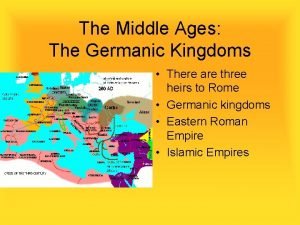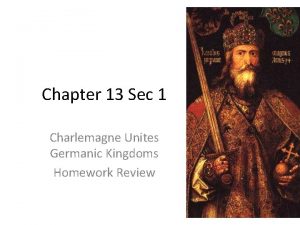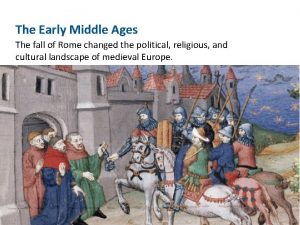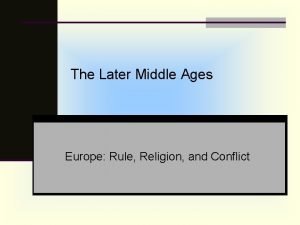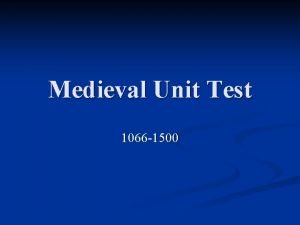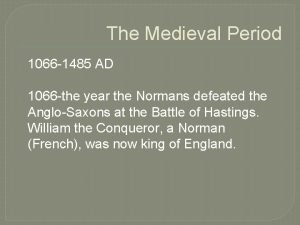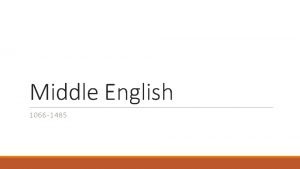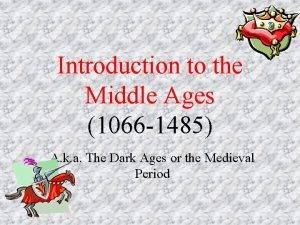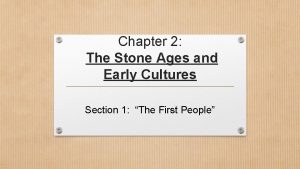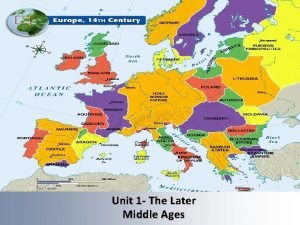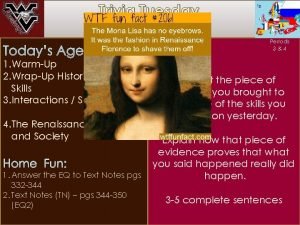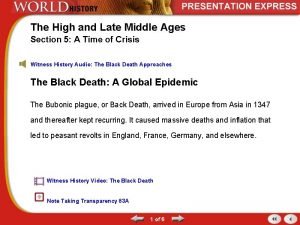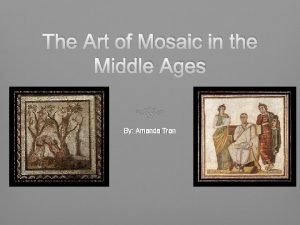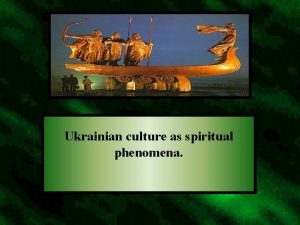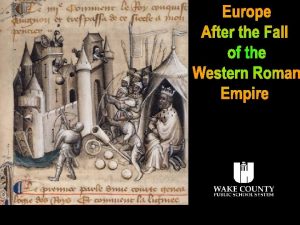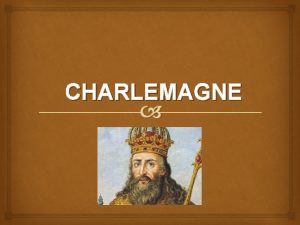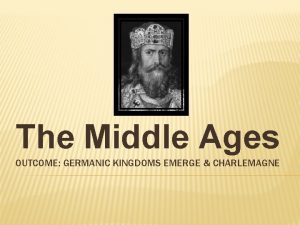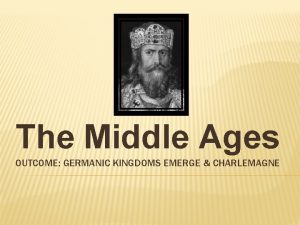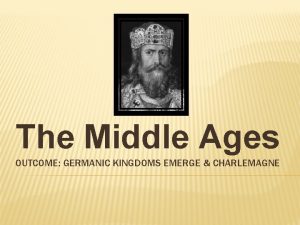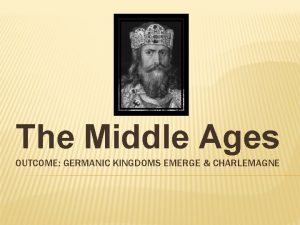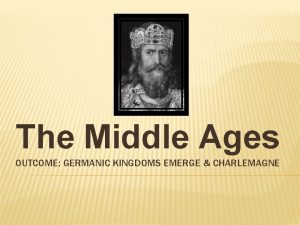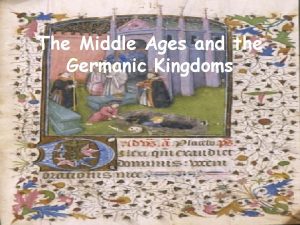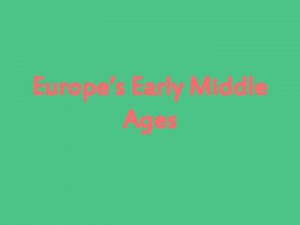UNIT 1 The Early Middle Ages Germanic kingdoms
















- Slides: 16

UNIT 1: The Early Middle Ages. Germanic kingdoms and the Byzantine Empire Geography & History 2ºESO

1. The Middle Ages. Stages and civilisations. 1. 1 The Early Middle Ages and its stages. • 3 rd century: Germanic tribes began infiltrating the Roman Empire • 395: Theodosius divided the empire into two parts – Western Roman Empire (capital Rome) – Eastern Roman Empire (capital Constantinople) • Different historical path. – Western Roman Empire • It suffered invasions from germanic tribes and was losing territories. • Finally, in 476 it fell into the hands of the Heruli and disappeared. – Eastern Roman Empire • It survived to the invasions. • Lasted until 1453 defeated by the Turks. • MIDDLE AGES STAGES – Early Middle Ages – 5 th c. (476) - 10 th c. – High Middle Ages – 11 th -13 th c. – Late Middle Ages – 14 th – 15 th c. (1476 or 1492)

1. The Middle Ages. Stages and civilisations. 1. 2 Medieval civilisations • Orthodox Chistianity – Byzantine Empire – Roman traditions but with greek language – They do not recognise the religious primacy of the Pope of Rome. • Latin Christendom – Roman Catholic Christian religión – Pope as the leader of the Church – Many different kingdoms: Feudal Monarchies. • Visigoths, Franks, Holy Roman Empire, etc. • Islam – – New religion from the preaching of Mahoma 7 th century Arabia Its followers were called Muslims

2. The Byzantine Empire (I) General Characteristics. 2. 1 Historical Evoluction • From the 5 th century, different periods. – 6 th c. • The empire reach its peak (period of splendor) • Emperor Justinian I – He wanted to restore the old Roman Empire – Conquered the territories of north Africa, Italy and the south of the Iberian peninsula. – They were lost upon his death. – 7 th c. • Muslims conquered the richest provinces. • Period of crisis. – Middle of the 11 th century on… • Deep crisis • The turks conquered Constantinople in 1453. End of the empire.

2. The Byzantine Empire (I) General Characteristics. 2. 2 Government and administration. • Emperor – All the power – Title of Basileus • Administration – Civil servants – Legistation based in Roman law. – Corpus Iuris Civilis: Code of laws compiled and upgraded by Justinian I • Territorial administration – Territory organised into provinces – Provinces governed by a political and military head.

2. The Byzantine Empire (I) General Characteristics. 2. 3 The Byzantine economy • Agriculture – – It was the basis of the economy Latifundia: Large properties of land. Owners: monasteries, nobles. Workers: serfs • Cafts – Luxury articles • Commerce – Benefitted from the strategic position of Constantinople. • Between Europe and Asia. • Between The Mediterranean and the Black sea.

3. The Byzantine Empire (II). Society and art. 3. 1 Byzantine society • Organised into three levels – Upper class (owners of latifundia, ocuppied high positions in government) • Aristocracy • High-ranking Church officials – Middle class • Wealthy businessmen • Free farmers – Lower class • Serfs • Slaves

3. The Byzantine Empire (II). Society and art. 3. 2 The Church and its problems. • Great power and influence – Crowned the emperor – It held large latifundia – Great influence in population (it controlled the spiritual aspects) • It faced two problems – Iconoclastic controversy • Emperors vs Church • The emperor prohibited the icons (to reduce the power of the church) • The icons were finally accepted. – East-West Schism • Rivalry between th Patriarch of Constantinople and the Pope of Rome. ¿Who was the head of the Church? • 1054: Separation of the Eastern and the Western Church • Eastern Church= Orthodox Church Evangelization of the Slavic tribes.

3. The Byzantine Empire (II). Society and art. 3. 3 Byzantine art. • Architecture – Poor materials (brick) – Supports • • Columns Semicircular arches Flat or vaulted ceilings. Pendentives – Main building: church. – Plan • Rectangular/ Square/ Octagonal/Greek cross. – Examples: Hagia Sophia. • Mosaics – Decoration of the walls and domes (interior) – Examples: Mosaic of Justinian and his wife Theodora • Icon – Religious images on boards decorated with gold leaf.

4. The settlement of the Germanic tribes in the West. 4. 1 The Germanic Kingdoms. • After the disappearence of the Western Roman Empire Germanic Kingdoms. • Most important ones: Franks and Visigoths. • Other Germanic Kindoms – Ostrogoths • Italy. • King Theodoric. • Conquered by the Byzantine empire (Justinian I) – Lombards • North of Italy • Powerful kingdom • Lasted two centuries. – Angles and Saxons • England

4. The settlement of the Germanic tribes in the West. 4. 2 The consequences of the settlement • Political consequences – Disappeareance of the Western Roman Empire. – Fragmentation of the territory into small independent kingdoms. • Economic consequences – Process of ruralisation: process of change from an urban economy (crafts and commerce) to a rural economy (agriculture and livestock) • Workshops and commerce almost dissapeared. – Autarchy: self-sufficient economy (no commerce) • Social consequences – New elite: germanic peoples – Middle class lost importance – Serfs and slaves multiplied • Cultural consequences – Period of crisis – Knowledge was reduce to isolated places: monasteries.

5. The Germanic Kingdoms (I). The Visigoths. 5. 1. Historical evolution • Visigoths settled in the Roman privince of Gaul – Pact with the Roman Empire • Visigoths governed the region in exchange of defending it from attacks by other tribes. KINGDOM OF TOULOUSE (415 -507) • Both sides of the Pyrenees • Capital in Toulouse • Heyday with Euric • Battle of Vouillé (507) • Franks defeated the Visigoths • Alaric II died • Visigoths move to the Iberian Peninsula. KINGDOM OF TOLEDO (507 -711) • Capital in Toledo • Leovigild • Conquered the entire Iberian Peninsula • Reccared • Converted to Catholicism in the third Coulcil of Toledo. • Battle of Guadalete (711) • Muslims conquered the Iberian Peninsula • End of Visigothic Kingdom

5. The Germanic Kingdoms (I). The Visigoths. 5. 2. The way of life of the VIsigoths • Political organisation – – Elective monarchy weaker monarchy Aula Regia • Council for advising the King • Composed of nobles and important ecclesiastics • Economy – – • Centred on agriculture Latifundia in the hands of the nobility and Church. Society – – Upper class • Nobles • High level clergy (bishops and abbots) Lower class • Small landowners • Latifundia workers • Craftsmen • Merchans • Serfs • Culture – – • Impoverished In the hands of the Church Art – – Small churches Horseshoe arch.

6. The Germanic Kingoms (II). The Franks and the Caroligian Empire. 6. 1 Historical evolution. From kingdom to empire. • Franks settled in the Roman province of Gaul (after the Visigoths). – Merovigian dinasty • Founded by Clovis. – Caroligian dinasty • Pepin the Short – Founded the dinasty. • Carlegmagne – – – Pepin´s son. Period of greatness Wanted to re-established the old Roman Empire Conquered a lot of territories in central Europe Was crowned emperor by Pope Leo III (800) • Louis the Pious – Charlemagne´s son. – After his dead, the empire was divided between his three children.

6. The Germanic Kingoms (II). The Franks and the Caroligian Empire. 6. 2. The Caroligian way of life. • Government – Emperor • Territorial administration – Counties • Count • Interior provinces – Marches • Marquis • Defensive borderland provinces • It had a powerful army. • Economy – Based on agriculture – Latifundia belonged to the aristocracy and Church. – Urban activities declined – Commerce was limited to luxury items to the rich and powerful people. • Society – Higher class • Nobles • High ranking ecclesiastics – Middle class • Farmers • Craftsmen • Merchants – Lower class • Serfs: bound to work They could not leave the land without permission.

6. The Germanic Kingoms (II). The Franks and the Caroligian Empire. 6. 3. Culture and art • Cultural reinassance – During the period of Charlemagne – Capital of the empire in Aachen. – Alcuin of York.
 Germanic kingdoms in the middle ages
Germanic kingdoms in the middle ages Why are the middle ages called the dark ages
Why are the middle ages called the dark ages Renaissance vs medieval art
Renaissance vs medieval art Charlemagne unites germanic kingdoms
Charlemagne unites germanic kingdoms Early middle ages
Early middle ages Early middle ages
Early middle ages The middle ages 1066-1485 unit test
The middle ages 1066-1485 unit test The middle ages 1066 to 1485: unit test
The middle ages 1066 to 1485: unit test The middle ages 1066 to 1485 unit introduction
The middle ages 1066 to 1485 unit introduction The middle ages 1066 to 1485 unit test closed book
The middle ages 1066 to 1485 unit test closed book Chapter 7 early childhood ages 3 through 5
Chapter 7 early childhood ages 3 through 5 The stone ages and early cultures
The stone ages and early cultures Map of europe in middle ages
Map of europe in middle ages Renaissance vs middle ages
Renaissance vs middle ages Byzantine floral arrangement
Byzantine floral arrangement The high and late middle ages section 5 quiz
The high and late middle ages section 5 quiz Medieval mosaic art
Medieval mosaic art
